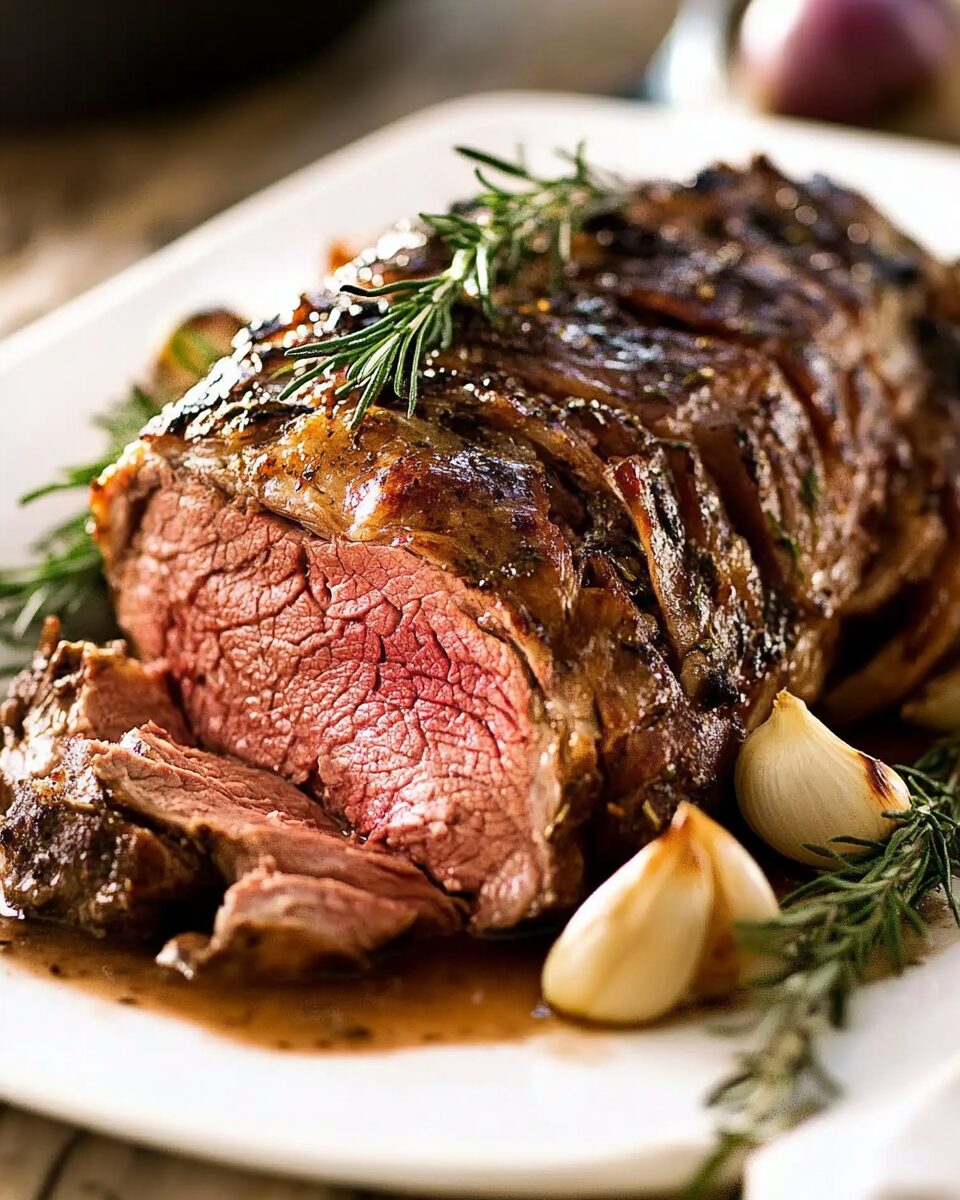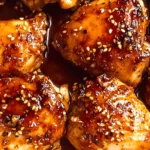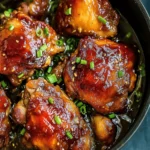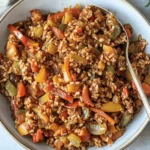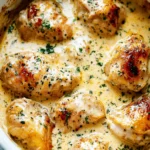The aroma of rosemary and garlic wafts through your kitchen as this glorious leg of lamb slow-roasts to golden perfection. The meat turns tender enough to pull apart with tongs, and the pan juices transform into a luscious gravy that’s nothing short of divine.
Perfect for Sunday dinners, Easter celebrations, or impressing guests at any festive gathering, this lamb recipe brings together rustic comfort and timeless elegance. With minimal hands-on effort and forgiving cook time, it’s the kind of dish that turns anyone into a roast master.
Full Recipe:
-
1 bone-in leg of lamb (approx. 2.25 kg / 4.5 lb)
-
Salt and black pepper
-
1.5 tbsp olive oil
-
1 head garlic, halved horizontally (unpeeled)
-
1 large onion, quartered (unpeeled)
-
2–4 sprigs fresh rosemary
-
3 cups low-sodium beef stock
-
2 cups water
For the Gravy:
-
4 tbsp all-purpose flour
-
1 cup water
-
Salt and pepper, to taste
Directions:
-
Preheat oven to 170°C/335°F (150°C fan).
-
Place garlic, onion, and rosemary in a metal roasting pan.
-
Season lamb generously with salt and pepper. Place it on the aromatics, fat-side down. Drizzle with olive oil.
-
Pour beef broth and water into the pan around the lamb. Cover tightly with foil.
-
Roast for 4.5 hours. Remove from oven and check if the meat can be pulled apart with a fork. If not tender, re-cover and continue roasting.
-
Once tender, uncover and roast for another 45 minutes until browned.
-
Transfer lamb to a serving platter and loosely cover with foil to rest.
-
To make gravy, skim off some fat from the pan. Set pan over medium-high heat.
-
Add flour and whisk into the juices to make a roux.
-
Slowly whisk in water and cook until thickened to your preferred gravy consistency.
-
Strain gravy and serve with lamb.
Prep Time: 10 minutes | Cooking Time: 5 hours 15 minutes | Total Time: 5 hours 25 minutes
Kcal: 605 kcal | Servings: 8 servings
A Timeless Classic: The Beauty of Slow Roasted Garlic Rosemary Lamb
Few dishes command the attention and respect of a beautifully cooked leg of lamb, especially when it’s slow-roasted to tender, fall-apart perfection. This preparation method has stood the test of time for a reason — it transforms a hearty cut of meat into a celebratory centerpiece worthy of holidays, family dinners, and weekend gatherings. The Slow Roasted Garlic Rosemary Lamb recipe is not only deeply flavorful but also incredibly forgiving and simple to execute, making it an ideal choice for both beginners and seasoned cooks alike.
The Slow Roasting Method: Why It Works
The brilliance of slow roasting lies in time and temperature. By gently cooking the lamb leg at a lower temperature for several hours, the muscle fibers gradually break down, allowing the connective tissue to melt into gelatin and infuse the meat with moisture and flavor. The result is lamb so tender that it can be pulled apart with tongs, requiring no carving skills or special tools.
This technique is especially suited for a leg of lamb, a cut that is naturally leaner than the shoulder and can be prone to dryness if cooked too quickly. By using a bed of aromatics and a shallow bath of broth, the lamb is both protected from drying out and continuously basted in flavor-rich steam.
The Role of Garlic and Rosemary in Flavor Development
Garlic and rosemary are the pillars of Mediterranean and Middle Eastern lamb preparations. Their earthy, aromatic profiles pair harmoniously with the richness of lamb, cutting through the fat and enhancing its natural savory notes. When garlic is roasted whole with the lamb, it mellows into a soft, almost sweet component that complements the dish without overpowering it. The rosemary, on the other hand, provides a piney freshness that elevates the entire roast with just a whisper of herbal brightness.
These two ingredients don’t just flavor the meat—they also transform the pan juices into a complex base for the gravy, making them indispensable to the overall dish.
Cultural Significance of Roasted Lamb
Roasted lamb holds cultural and culinary significance around the world. From the Easter tables of Europe to the festive meals of the Middle East, lamb has long been a symbol of celebration and hospitality. In Greece, slow-roasted lamb is a staple of Easter Sunday, often seasoned with lemon, garlic, and oregano. In France, a leg of lamb (gigot d’agneau) is a classic centerpiece for a Sunday lunch, traditionally roasted with herbs and served pink inside.
The method of slow roasting, as used in this recipe, channels these international traditions while simplifying the process, making it approachable for home cooks everywhere.
What Makes This Recipe So Forgiving?
One of the most appealing aspects of this slow roasted lamb is how flexible it is. Unlike recipes that rely on precision timing to achieve a perfect pink center, this dish welcomes variability. If your roast goes a little over the recommended time, you won’t end up with dry meat — in fact, the lamb becomes even more tender the longer it cooks, within reason.
It also reheats exceptionally well, making it an excellent choice for meal prep or cooking ahead for gatherings. The flavors deepen as the meat rests and the juices redistribute, ensuring that even leftovers taste just as good as the main event.
Serving Suggestions and Ideal Sides
While the lamb itself is a showstopper, its impact is amplified by thoughtful side dishes. Classic accompaniments like roasted potatoes (especially crispy duck-fat or olive oil potatoes), buttered green beans, or honey-glazed carrots work beautifully. A minted yogurt sauce or chimichurri can add a fresh, tangy element that balances the richness of the meat.
For a more Mediterranean experience, consider serving it with couscous, tzatziki, or a Greek salad. Or, for a rustic British-style meal, pair it with mushy peas, mint sauce, and a drizzle of the savory pan-made gravy.
No matter the combination, the lamb becomes the centerpiece, tying all the flavors together with its deep, satisfying character.
Tips for Making It Perfect Every Time
1. Use a meat thermometer wisely: Although this recipe doesn’t aim for a specific internal temperature for pink lamb, a thermometer can still be useful to ensure it’s cooked through. For fall-apart lamb, aim for an internal temp above 195°F (90°C).
2. Don’t skip the resting period: After roasting, the lamb should rest under foil for at least 20–30 minutes. This allows the juices to redistribute and results in a more moist and flavorful bite.
3. Elevate with aromatics: The onion, garlic, and rosemary under the lamb aren’t just for flavor—they also act as a roasting rack, allowing heat to circulate evenly and preventing the lamb from stewing in its own juices.
4. Skim the fat from pan juices: Before turning the roasting liquid into gravy, be sure to skim off some of the fat. This results in a cleaner, more refined sauce that better highlights the lamb’s flavor.
5. Choose your lamb wisely: A bone-in leg of lamb will yield more flavor and structure during roasting. However, boneless works well too, especially if you’re looking for an easier carving experience.
Variations to Explore
While the classic garlic and rosemary pairing is hard to beat, this recipe invites customization based on regional preferences and flavor profiles:
-
Moroccan-style: Add ground cumin, coriander, cinnamon, and a pinch of chili flakes to the lamb rub. Swap beef stock for chicken stock with saffron.
-
Greek-style: Add lemon zest and oregano, and replace some of the broth with dry white wine.
-
Indian-inspired: Rub the lamb with garam masala, turmeric, and garlic-ginger paste, and serve with raita and basmati rice.
-
French twist: Add a splash of red wine and thyme sprigs to the pan, and use Dijon mustard as a light coating before roasting.
Each variation keeps the spirit of the recipe intact while adding a personal twist that reflects different global cuisines.
How to Use Leftovers
If you’re lucky enough to have leftovers, there are countless ways to enjoy them beyond reheating:
Advertisement
-
Lamb sandwiches with gravy or aioli, stuffed in crusty baguettes or pita
-
Lamb tacos with pickled onions, fresh cilantro, and yogurt drizzle
-
Lamb shepherd’s pie, made by layering meat and vegetables under mashed potatoes
-
Lamb pasta, shredded into tomato sauce with olives and fresh parsley
-
Lamb and grain bowls, paired with quinoa or farro and roasted veggies
The versatility of this slow-roasted lamb ensures that no bite goes to waste.
Conclusion: A Dish That Delivers Every Time
This Slow Roasted Garlic Rosemary Lamb recipe embodies everything we love about comfort food: simple ingredients, rich flavors, and an end result that feels like a reward. It brings people together, fills your kitchen with mouthwatering aromas, and leaves guests raving.
Whether you’re preparing it for a festive holiday, a casual Sunday dinner, or a cozy evening at home, this dish guarantees satisfaction with minimal stress. With just a little patience and the right technique, you’ll have a main course that not only looks impressive but tastes like something straight out of a fine dining kitchen.
Add this to your cooking repertoire, and you’ll always have a go-to dish for when it really counts.

